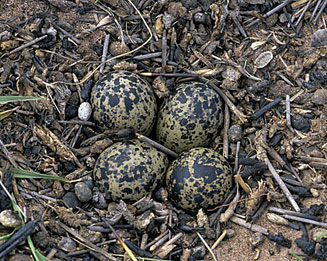|
Vanellus senegallus (African
wattled lapwing, Wattled plover)
Lelkiewiet [Afrikaans]; Hurekure (generic name for
lapwing) [Shona]; Nghelekele [Tsonga]; Lelkievit [Dutch]; Vanneau du Sénégal
[French]; Senegalkiebitz [German]; Abibe-carunculado [Portuguese]
Life
> Eukaryotes >
Opisthokonta
> Metazoa (animals) >
Bilateria >
Deuterostomia > Chordata >
Craniata > Vertebrata (vertebrates) > Gnathostomata (jawed
vertebrates) > Teleostomi (teleost fish) > Osteichthyes (bony fish) > Class:
Sarcopterygii (lobe-finned
fish) > Stegocephalia (terrestrial
vertebrates) > Tetrapoda
(four-legged vertebrates) > Reptiliomorpha > Amniota >
Reptilia (reptiles) >
Romeriida > Diapsida > Archosauromorpha > Archosauria >
Dinosauria
(dinosaurs) > Saurischia > Theropoda (bipedal predatory dinosaurs) >
Coelurosauria > Maniraptora > Aves
(birds) > Order: Charadriiformes
> Family: Charadriidae > Genus: Vanellus
Distribution and habitat
Occurs across sub-Saharan Africa; in southern Africa it is fairly common in Zimbabwe,
northern Botswana and Namibia (including the Caprivi Strip), north-eastern South
Africa, Swaziland and central and southern Mozambique. It generally prefers
waterlogged grassland at streams, seeps edges of marshes and flood plains, as
well as exposed areas along the edges of lakes and pans, burnt grassland and
cultivated land.
|
 |
|
Distribution of African wattled lapwing in southern Africa,
based on statistical smoothing of the records from first SA Bird Atlas
Project (©
Animal Demography unit, University of
Cape Town; smoothing by Birgit Erni and Francesca Little). Colours range
from dark blue (most common) through to yellow (least common).
See here for the latest distribution
from the SABAP2. |
Movements and migrations
Resident while breeding, but
nomadic during the rainy season.
Food
It mainly eats insects, doing most of its foraging by
walking slowly while scanning the ground for prey to catch. The following food items have been recorded
in its diet:
- invertebrates
- grass seeds
Breeding
- Monogamous, territorial solitary nester, with the male defending its
territory vigorously against intruders (mainly other African wattled
lapwings) by striking them with its wings. Displays and fights are most
intense at the beginning of the breeding season, as later males only call
and use threat postures to defend their territory.
- The nest (see image below) is a shallow depression in the ground,
several of which are created by the male before the female chooses one to be
lined thickly with grass stems, roots, pebbles and dry dung. It is typically
placed on bare ground in short or burnt grassland, or occasionally small
islands in marshy areas.
 |
|
|
African wattled plover nest with eggs, Sericea,
South Africa. [photo Warwick Tarboton ©] |
|
- Egg-laying season is from July-December, peaking from September-October.
- It lays 2-4 eggs, which are incubated by both sexes for about 28-32
days, often mobbing predators which come to close.
- The chicks leave the nest within 24 hours, and are always tended by at
least one adult, fledging at about 40 days old but only leaving the family
group at the start of the following breeding season.
Threats
Not threatened, in fact it may have benefited from the
modification of habitats by humans.
References
-
Hockey PAR, Dean WRJ and Ryan PG 2005. Roberts
- Birds of southern Africa, VIIth ed. The Trustees of the John Voelcker
Bird Book Fund, Cape Town.
|
